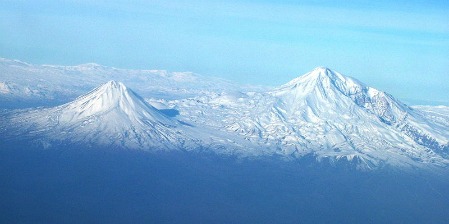
Left to right: Lesser Ararat at 3896 meters & Greater Ararat at 5137 meters. The latter is the purported resting place of Noah
While writing another post today there were a couple of annoying programs on my local cable stations, both on channels that are supposed to be about science and history. Or used to be anyway. The first was a documentary on ghosts, the other a look at the legend of Noah’s Ark. The former was bad enough, the latter gave the flood story way to much credence and covered it with far too little objectivity. Ghost shows are just too damn ridiculous, so I opted for the Ark nonsense. That program took the dodge of a local flood, basically reducing Noah to a mystical guy who builds an advanced — by Bronze Age standards — raft with a lean-to houseboat on one end and maybe some goats and chickens tied up on the other side.
They could have mentioned for example that no matter how much “pitch” was used to seal it, a wooden boat the size of the biblical Ark would not be seaworthy for long. Even relatively gentle waves would produce stress beyond the strength of wooden ship building materials available at the time. Let alone a pitching, rolling ocean in the middle of a rainstorm laying down several feet of rain an hour for weeks on end.
The program could have introduced viewers to some basic thermodynamics and meteorology, how much water can be held by the atmosphere at specific temperatures and pressures for example. I haven’t worked out what a shell of liquid water representing a global rise in sea level of several thousand meters would imply if held as vapor. I’ll go out on a limb here and predict it means a five to tenfold increase in ambient pressure and a rise in global temperatures of a couple of hundred degrees. This is a radically different planet than the one we live in. It would be covered with thick clouds from poles to equator, from space we’d be a brilliant puffy white cotton ball. On the surface it would be darker than a moonless night and hot enough to cook the flesh right off the bones.
Geologists know a lot about which sediments and what marine environments produce various types of sedimentary rocks and how those deposits can be cooked and folded, some even eroding away to form totally new deposits. Limestone and shale require different kinds of conditions to form than sandstone. And yet all over the world there are layers of sandstone sandwiched between other kinds of rock. My friend Ed Brayton has a great zinger where he wryly notes “Right in the middle of a massive global flood a desert broke out.”
But I heard precious little modern geology or science on the show. And that’s a disservice. Because that’s what the actual flood story in Genesis says or clearly implies. It was a giant boat with two of a whole bunch of species on board and enough food and water to keep them alive for the better part of a year, the flood was global, so vast it created many geological features we see today, and it rained enough in 40 days to cover the mountains. The ark eventually rested on Mt. Ararat giving a minimum water depth of 5,137 meters or almost 17,000 ft. When the water receded 7 months later (Where exactly does a global sea recede to, underground caves? ), God made the first rainbow as a sign he would not destroy the world again. Or at least anytime soon.
Speaking of God and climate, I didn’t get a chance to make it to Rick Perry’s prayathon down in Houston this weekend. But I can tell you it’s about 105° degrees outside in Austin right now, not a cloud in the sky. One would think if Noah witnessed a divine flood covering the earth, God would have the ability to give Rick Perry a gentle summer rain shower over a parched Lone Star State smack dab in the middle of the worst drought on record. Dumb question: is there any kind of time horizon for effectiveness on these things? Can we establish a date or devise a sliding scale for the purpose of testing the prayer-and-effect hypothesis?

Actually Steven, I’m working on an article about exactly this topic, complete with power measurements. Drop me a line at UT Austin and I’ll be happy to go into detail. :-) nmcvaugh at mail.utexas and you know the .edu part.